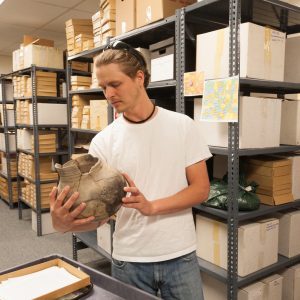The collection housed in the Archaeological Repository of Colorado State University (AR-CSU) represents over 13,000 years of cultural and history of the Northern Colorado region. The collection includes artifacts from over 1,200 archaeological sites and chronicles the region’s rich history from the early Clovis culture to Colorado’s earliest evidence of corn farming, as well as historical items.
Mission Statement
The mission of the Archaeological Repository of Colorado State University is to curate and preserve archaeological collections and promote their educational, scientific and cultural use to benefit a diverse public. The Repository manages the archaeological artifacts and associated paperwork and images of the Colorado State University’s Department of Anthropology and other archaeological collections from public and private lands in Colorado obtained in the course of cultural resource management (CRM) and field schools. The vast majority of archaeological collections held in the repository are from Northern Colorado and represent over 13,000 years of cultural history in the region. The collections are available to descendant communities, researchers, university students, and museums interested in Colorado prehistory and early history for visits, research, and artifact loans.
Vision
The vision of ARCSU is to sustain an Archaeological Repository where artifacts are housed, preserved and made accessible for research in a professional environment.
- Where students and other scholars can learn current collections management and preservation techniques, conduct research, and complete projects, theses and dissertations.
- Build and maintain relationships with descendant communities, state and federal agencies, and local, regional and state museums.
- Collaborate with our stakeholders and community partners.
- Participate in educational programs and develop museum quality exhibits for the public to engage in the prehistory and history of Colorado.
Equipment
- Collection cataloguing supplies
- Archival-quality storage materials
- OCR flatbed scanner
Research
Extensive collection of artifacts from northern Colorado, in particular the North and South Platte and Colorado River basins. Collection contains both prehistoric Native American and historic Euro-American artifacts. The Archaeological Repository contains items collected primarily through two sources: cultural resource management projects by the CSU Laboratory of Public Archaeology (LOPA) as well as the CSU Archaeology Field School. Majority of collections gathered between the late 1960s and the late 1980s, with modest additions added since that time from a variety of additional sources. The Repository also contains field notes, photographic materials, and reports associated with these artifacts.
Hands-On Training and Learning for Students
The repository is an active laboratory for learning. Students may complete internships and practicums for university credit and gain hands-on training in artifact curation and museum standards and practices. Students outside the discipline of Anthropology are welcome if they are interested in pursuing museum work. Paid internships often come available for specific projects. If you are interested in working in the repository, contact Jason LaBelle.

ANTH 486 Practicum
Students have the opportunity to complete 2 or 3 credit ‘Practicum in Anthropology’ under the direction of the Archaeological Collections Coordinator. Currently students are working on an inventory project of the entire collection. Students will learn hands-on curation skills, have the opportunity to handle artifacts, and enter information concerning the artifacts into a database. If you are interested in completing a Practicum, contact Jason LaBelle.
History Colorado’s State Historical Foundation Grant Recipient
History
Professor Calvin Jennings established the CSU Laboratory of Public Archaeology (LOPA) and the Archaeological Repository in the mid-1970s. Under the direction of Dr. Jennings and Dr. Elizabeth Morris, LOPA completed hundreds of Cultural Resource Management projects throughout the Northern Colorado region for the US Forest Service, the Bureau of Land Management, and the US Bureau of Reclamation. This resulted in a collection of archaeological material that includes thousands of artifacts from over 1,200-recorded archaeological sites and over 800 isolated finds (approximately 700 cubic feet of archaeological material). The artifacts include an array of stone tools, ground stone, bone, ceramics, basketry, beads, shell, wood, and organics. As well as, historic artifacts from the 19th and 20th centuries such as glass bottles, tin cans, metal, tools, household items, and bullet casings.
The Repository is also home to the collections excavated during Field Schools facilitated by CSU (approximately 300 cubic feet of archaeological material). Professors, Dr. Elizabeth Morris, Dr. Lawrence Todd, and Dr. Jason LaBelle and their students surveyed and excavated several important sites over the years including Roberts Ranch and the Kaplan-Hoover bison bone bed in Larimer County, as well as the Pigg Site Pueblo in Montezuma County. Graduate students doing research and completing theses for their Masters degrees have utilized the field school collections extensively, but there is still much more research to do.
Along with the archaeological materials in the repository are extensive archival materials, which document the methods of excavation (approximately 300 cubic feet of archival documentation). The archival materials include paper documents such as field notes, reports, and artifact catalogs, to name a few. Other items include photographs, slides, project notes and inventories. It is crucial to preserve this material along with the artifacts so that the methods and provenience remain intact. The Repository also houses the archives of former CSU archaeology professors including Dr. Elizabeth Morris, Dr. Calvin Jennings, Dr. Lawrence Todd, and U.S. Forest Service Archaeologist, John Slay.
In 2015, Dr. LaBelle and the Archaeological Repository of CSU joined the “Pillars” workgroup formed by History Colorado and committed to being a regional partner for the preservation and interpretation of archaeological material across the state. From 2017 through 2023, Jeannine Pedersen-Guzman served as Archaeological Collections Coordinator, helping to manage the organization, preservation and outreach related to Repository collections and developing the Museum & Cultural Heritage Studies Undergraduate Certificate.